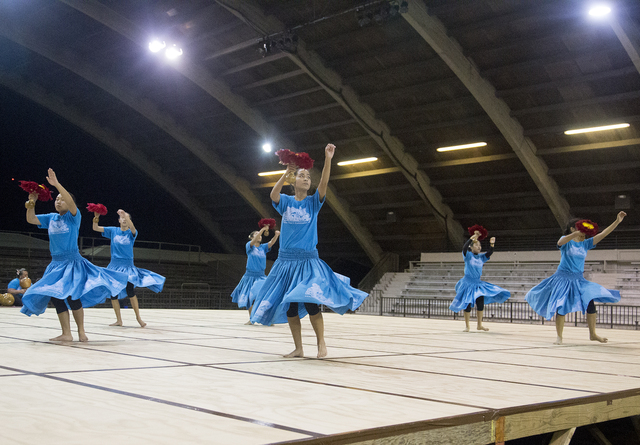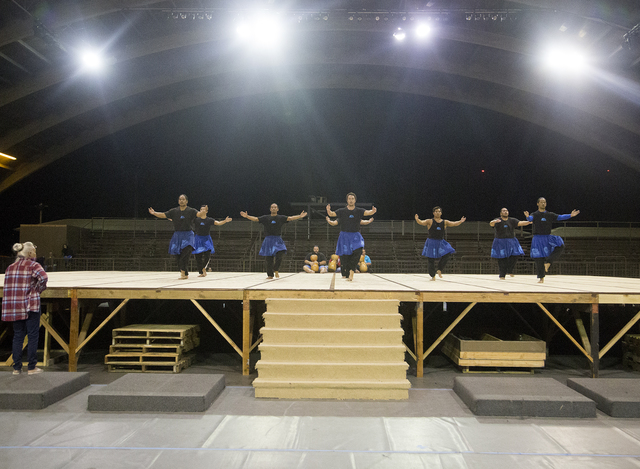Hilo represents with three halau
Three halau, all from Hilo, will represent Hawaii Island in the 52nd Annual Merrie Monarch Festival hula competition.
ADVERTISING
Halau Hula ‘O Kahikilaulani, under the direction of kumu hula Nahokuokalani Gaspang, will compete in the kane and wahine divisions.
The halau, founded by the late kumu hula Rae Fonseca, placed second last year in the kane division hula ‘auana, performing the lively 1920s mele “Hilo E” by Mary Heanu. In 2013, they placed third in kane overall and fourth in kane kahiko.
As they did last year, Gaspang’s men are going old school for the ‘auana with the 1935 Lena Machado classic, “Kauoha Mai,” also known as the “Keyhole Hula.” The lyrics speak of going to a lover’s home after being invited, only to find a locked door. The lover is seen through the keyhole, kissing someone else.
“I had a different mele in mind, but my alaka‘i, No‘eau Kalima, came to me and said, ‘What if we do “Kauoha Mai”?’” Gaspang explained. “I said, ‘OK, let’s do it then.’ And for our ka‘i (entrance), we’re using one of Keali‘i Reichel’s meles, ‘Ipo Lei Momi.’”
Gaspang’s eight kane, who range in age from 15 to their mid-20s, will dance their kahiko to a chant about Waipi‘o Valley.
“It was given to a special friend of mine’s grandmother and the grandmother gave it to her. She shared the chant with me,” Gaspang said. “The chant honors Kamehameha. … Waipi‘o was Kamehameha’s playground. After he gets tired, he goes back to Kohala. Well, after he goes back to Kohala, two chiefs — one from Maui, one from Kauai — wanted to invade Waipi‘o Valley. They never got the chance to invade Waipi‘o Valley, and that’s why the people of Waipi‘o honor Kamehameha.”
Gaspang said her kane made a pilgrimage to the taro patches of Waipi‘o to gain a clearer understanding of the story they’ll dance.
“They went to the lo‘i to go help move some boulders so water can go into the lo‘i,” she said. “They wanted to feel the mana around Waipi‘o Valley. They had a nice time … and they gave back. That’s the thing.”
Gaspang is also putting a smaller, and even younger wahine contingent on hula’s biggest stage, seven women between 13 and their early 20s.
“They’re not my most seasoned dancers but these girls are working and I think they’ll do what they need to do,” she said.
The wahine kahiko is “Kama‘e,” Gaspang said, in honor of Queen Lili‘uokalani.
“Manu Boyd said he … had done some research and believes that Kama‘e was Lili‘u’s grandmother who lived in Kona,” she said.
Gaspang said the wahine ‘auana is “He Nani Mokihana,” a Chinky Mahoe composition that, on its surface, is about the beauty of the mokihana berry, the official lei material of Kauai.
“To me, it’s like comparing a girl, her beauty, to the mokihana,” she said.
Gaspang said that while “winning would be a feather in our cap,” she’s more interested in showcasing the teachings of Fonseca, who said dancers take the stage “for the love of the hula.”
Also perpetuating the legacy of Fonseca, whose kumu was Merrie Monarch patriarch Uncle George Na‘ope, is kumu hula Emery Li‘ili‘iokalani Aceret, who is bringing his men’s halau, Na Kane ‘O Waiolama.
Aceret’s last Merrie Monarch appearance was in 2011 with his wahine, Halau Na Pua ‘O Uluhailama.
“I needed to regroup and get my thoughts together,” Aceret said, laughing heartily. He said his 13 kane range in age from 13 to 32 and most “have been dancing for less than a year.”
“Most are friends of friends who were coming to hula and they wanted to learn. So I taught them.”
Aceret said the kahiko mele is a traditional chant, “Pa Ku Kea‘au Lulu Waiakea.”
“It is a trilogy about Hi‘iaka and Lohiau,” he said. “Pele sent her sister to get Lohiau from Kauai, and this is the journey back to this island, when they went to see Pele in Volcano. They landed in Leleiwi, in Hilo, for a while and they ventured to Volcano after that. It’s about being in Hilo and taking their time going to Puna.
“When I was dancing for kumu Rae Fonseca, he only used this chant as a ka‘i, or entrance chant, so I’m honoring him this year with this mele, and I’m completing the whole mele.”
The ‘auana, Aceret said, will be a medley called “Na Mele Punahele ‘O Kahiki.”
“Kahiki was my kumu and punahele is favorite, so these are his favorite mele, which consist of ‘Maile Swing,’ ‘He Aloha No ‘O Honolulu,’ ‘Koali’ and ‘Hawaii No E Ka ‘Oi’,” he said.
Glenn Kelena Vasconcellos and Halau O Ke Anuenue are a fixture at the Merrie Monarch hula competition. It’s the 33rd appearance for the Hilo halau, who danced every year from 1989-2009 before taking a break.
Vasconcellos’ wahine will perform “‘O Mai ‘O Emalani” for kahiko, in honor of Queen Emma Kaleleonalani.
“It’s … from the book called ‘He Lei No Emalani,’” he said. “It’s part of a longer chant. It’s not the beginning. It’s kind of in the middle. And it was put together by Puakea Nogelmeier.”
Vasconcellos, who learned hula from his maternal aunt, Katherine Kimi Bator, said he chose the chant because “it was soft and simple.”
“I really liked it and went to do some research on it,” he said.
The group’s ‘auana, Vasconcellos said, is “Lei Ko‘ele,” which was written by the late Rev. Dennis Kamakahi “at the request of Aunty Elaine Ka‘opuiki,” who taught hula in Lanai City for four decades before her death in 1999.
“She had asked him to write a song for Lanai, much like he did for Molokai (‘Wahine ‘Ilikea’),” he said. “And so, he went and talked to the kupuna of Lanai. They met at a church and they brought old photographs and explained to him the things that went on before the island was used for pineapple. It was a ranching community. So what the song speaks about is that era.”
The multitalented Vasconcellos designs and sews his halau’s costumes and styles their hair, and is styling the Royal Court’s hair for the 27th year.
He said Saturday, which is parade day as well as ‘auana night, will be an especially busy day for him.
“I do a pa‘u unit at 5 o’clock. I do the court at 7,” Vasconcellos said. “I get home at 10, do the girls’ hair. I go back and do the court again at 3, and then head over to our dressing room to get the girls ready.”
There will be no Hawaii Island contestant in Thursday night’s Miss Aloha Hula competition. Two women representing Hilo halau entered last year. Although it takes a large commitment of time and energy from both student and kumu, it’s rare the Merrie Monarch’s home island goes without a candidate for hula’s most prestigious solo title.
“If you want to be a Miss Hula, you have to be on top of it,” Gaspang said. “I don’t want to pick somebody randomly and later go, ‘Oh, this one wasn’t up to it.’ You have to have all the qualities to be a Miss Hula.”






